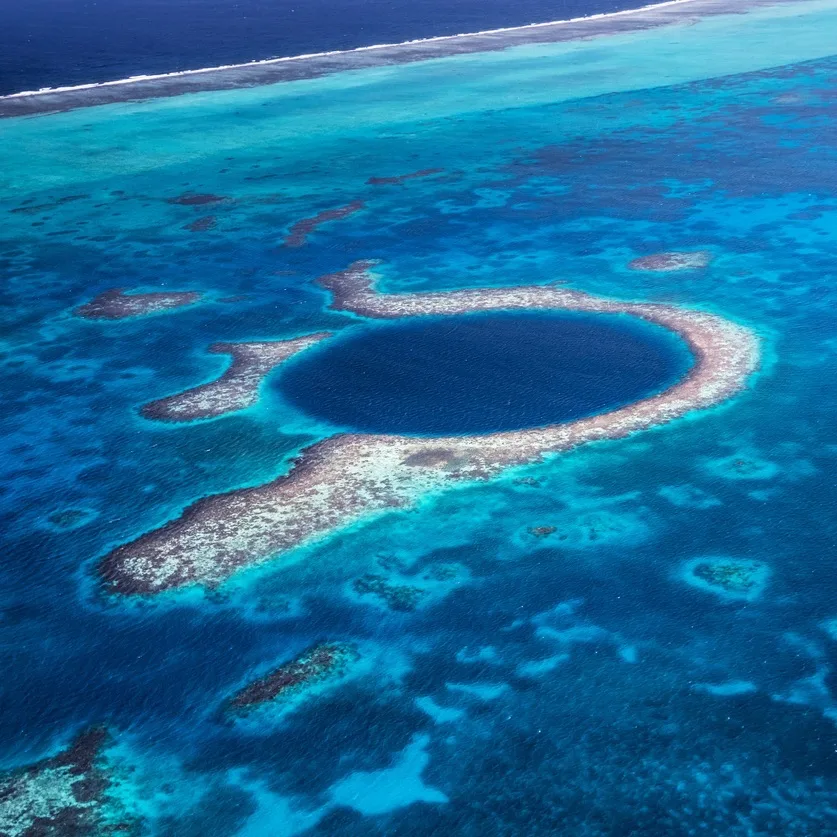OTHÓN P. BLANCO | The Mexican Caribbean is officially home to the world’s second-largest blue hole. Diving adventure, anyone? Here’s all you need to know about when it was discovered and where this natural wonder is located.
This amazing discovery was made by researchers at two Mexican scientific institutions, Campeche’s El Colegio de la Frontera Sur (Ecosur) and Mexico City’s Consejo Nacional de Ciencia y Techologia (Conacyt). It was actually found two years ago after studies were conducted in late 2021, but the report was only made earlier this month.
Taam Ja’, A ‘Deep Water’ Hole In The Bay Of Chetumal
Located in the Chetumal Bay, this deep blue hole was found on the Chetumal Bay’s seabed and reportedly stretches across an area of 147,358 square feet and is approximately 900 feet deep, with its mouth at a depth of around 15-16.5 feet below sea level. The hole was aptly named Taam Ja’, which translates as ‘deep water’ in one of the major Mayan languages spoken in the region.
Taam Ja’ is now the world’s second-largest blue hole (that we know of). The first was uncovered in China back in 2019, in the eastern Atoll by the Paracel Islands. It’s locally referred to as the “Dragon Hole” or the Sansha Yongle Blue Hole after the third emperor in the Ming Dynasty. This blue hole is around 987 feet deep.
Taam Ja’, A ‘Deep Water’ Hole In The Bay Of Chetumal
Located in the Chetumal Bay, this deep blue hole was found on the Chetumal Bay’s seabed and reportedly stretches across an area of 147,358 square feet and is approximately 900 feet deep, with its mouth at a depth of around 15-16.5 feet below sea level. The hole was aptly named Taam Ja’, which translates as ‘deep water’ in one of the major Mayan languages spoken in the region.
Taam Ja’ is now the world’s second-largest blue hole (that we know of). The first was uncovered in China back in 2019, in the eastern Atoll by the Paracel Islands. It’s locally referred to as the “Dragon Hole” or the Sansha Yongle Blue Hole after the third emperor in the Ming Dynasty. This blue hole is around 987 feet deep.
Two More Blue Holes Found In The Same Chetumal Bay
If this major discovery wasn’t enough, news soon came of two more deep blue holes in Chetumal Bay. Researchers from Ecosur, the same institution that broke the news about the world’s second-largest blue hole, released an update a mere couple of days later that two other blue holes had been uncovered in the depths of Chetumal Bay. These are located near the Taam Ja’ blue hole.
One of the holes is approximately 142 feet in depth, and the other is currently 140 feet deep. They are named Lool Ja’ (meaning ‘Flower of Water’) and Ch’och Ja (meaning ‘Salt Water’). The researchers made the announcement of these new additional deep blue holes at a seminar on Thursday in Chetumal city.
Discovery Good News For ‘Marine Scientific Research’ Say Ecosur Scientists
According to statements from the researchers when the discovery of Taam Ja’ was announced last week, these findings will help in the pursuit of further marine scientific research. A discovery such as this one gives researchers more ability to study what the environment of the region was like thousands of years ago and help to better recognize the geological process and so much more.
The scientific investigation into these blue holes of Chetumal Bay was guided in a variety of ways. Conducted in September 2021, researchers gathered the data by scuba diving, collecting water samples, using echo sounders, as well as profiling CTD. CTD (which stands for conductivity, temperature, depth) profilers quickly measures the specifics of the element of water as it moves through the water.
Can Travelers Visit These Natural Wonders Discovered?
As of late, there’s no report or talk from the researchers as to whether these giant underwater holes will become tourist attractions for Mexico’s Riviera Maya.
